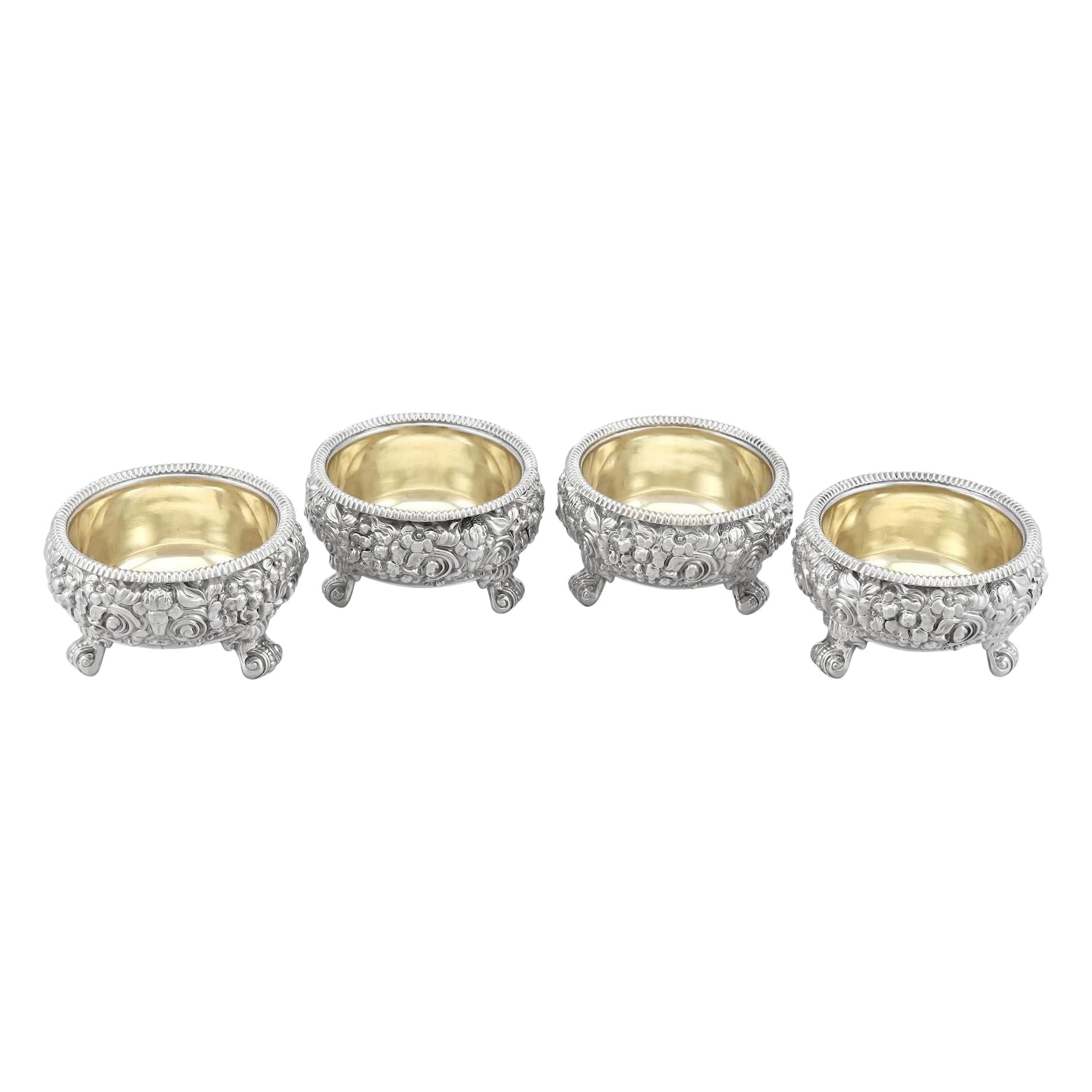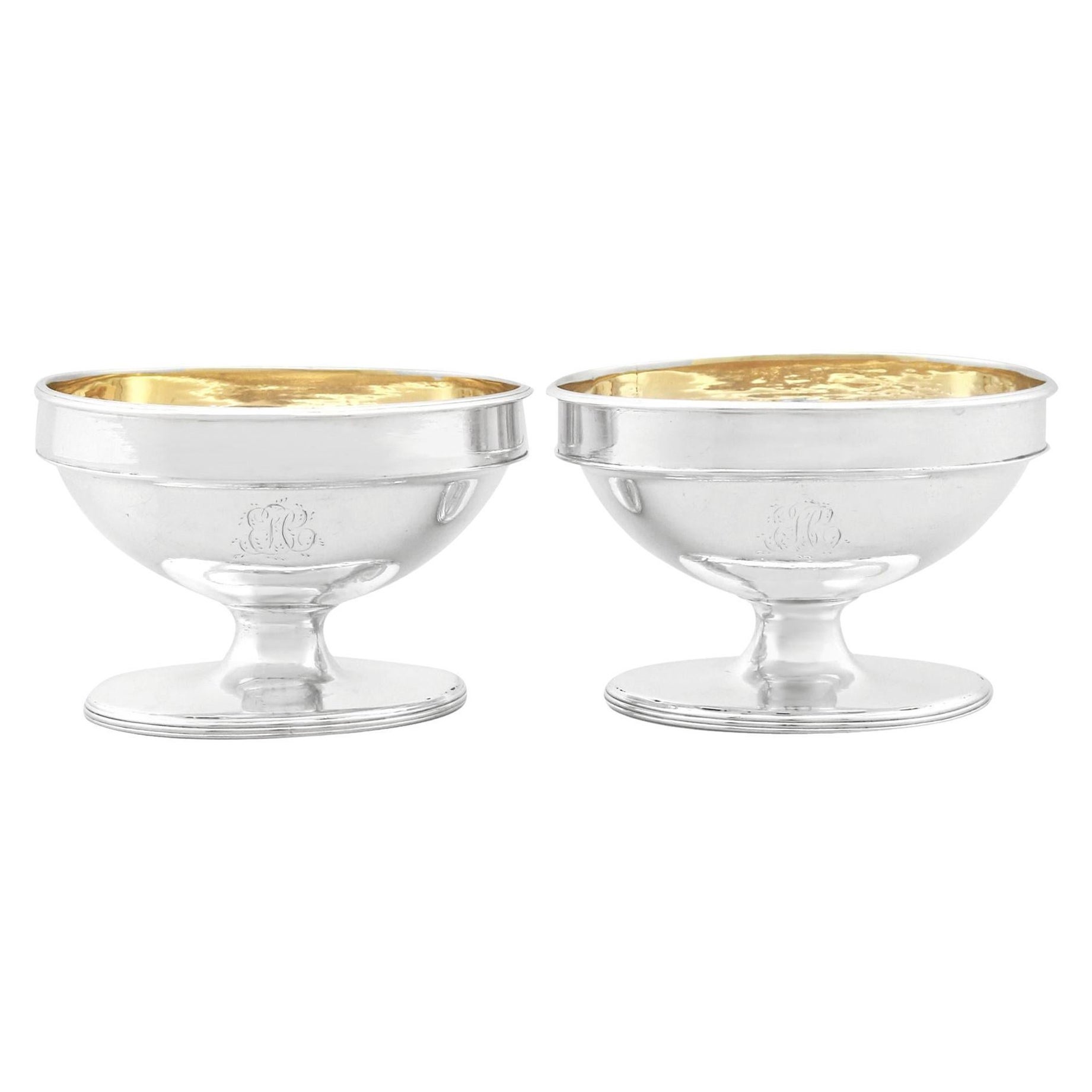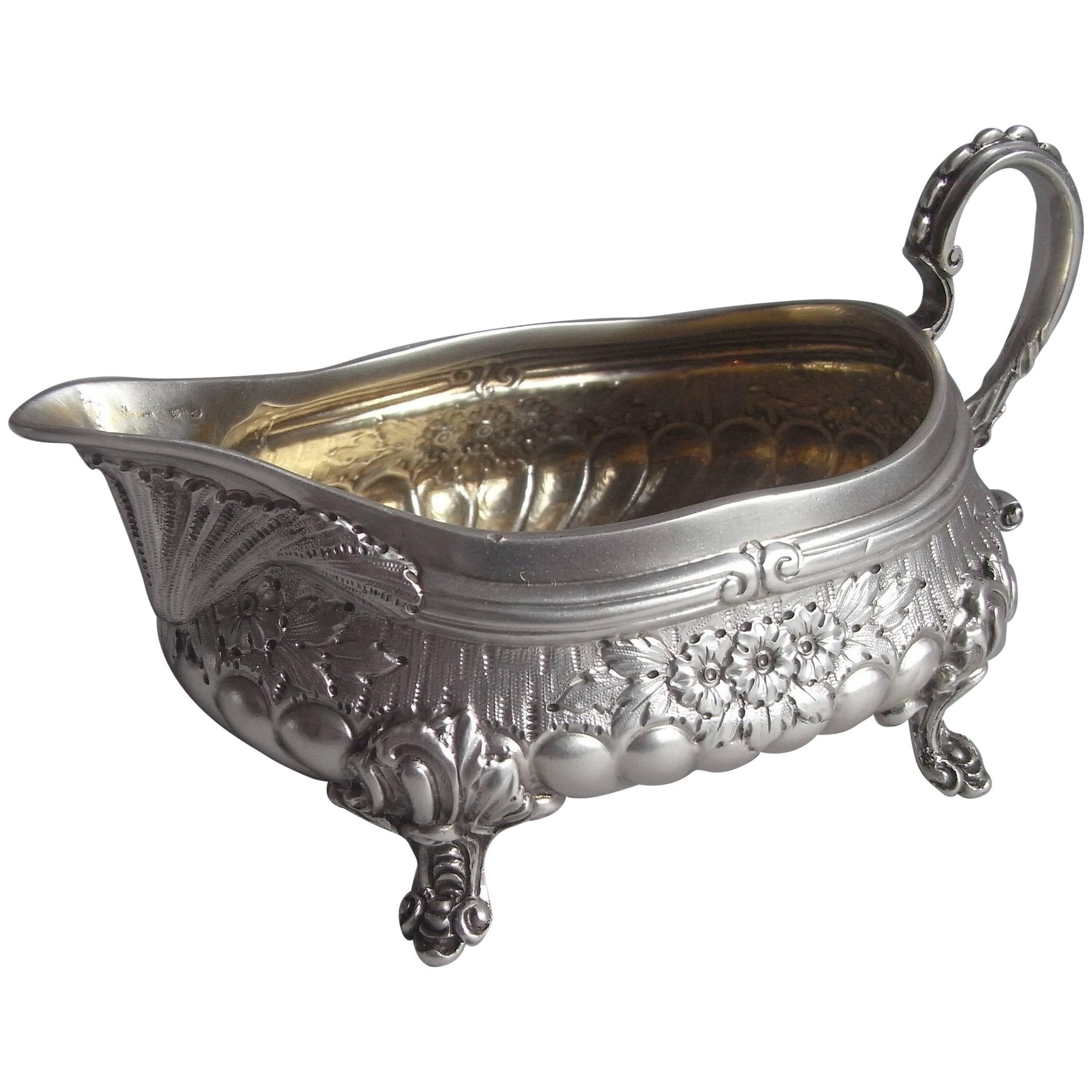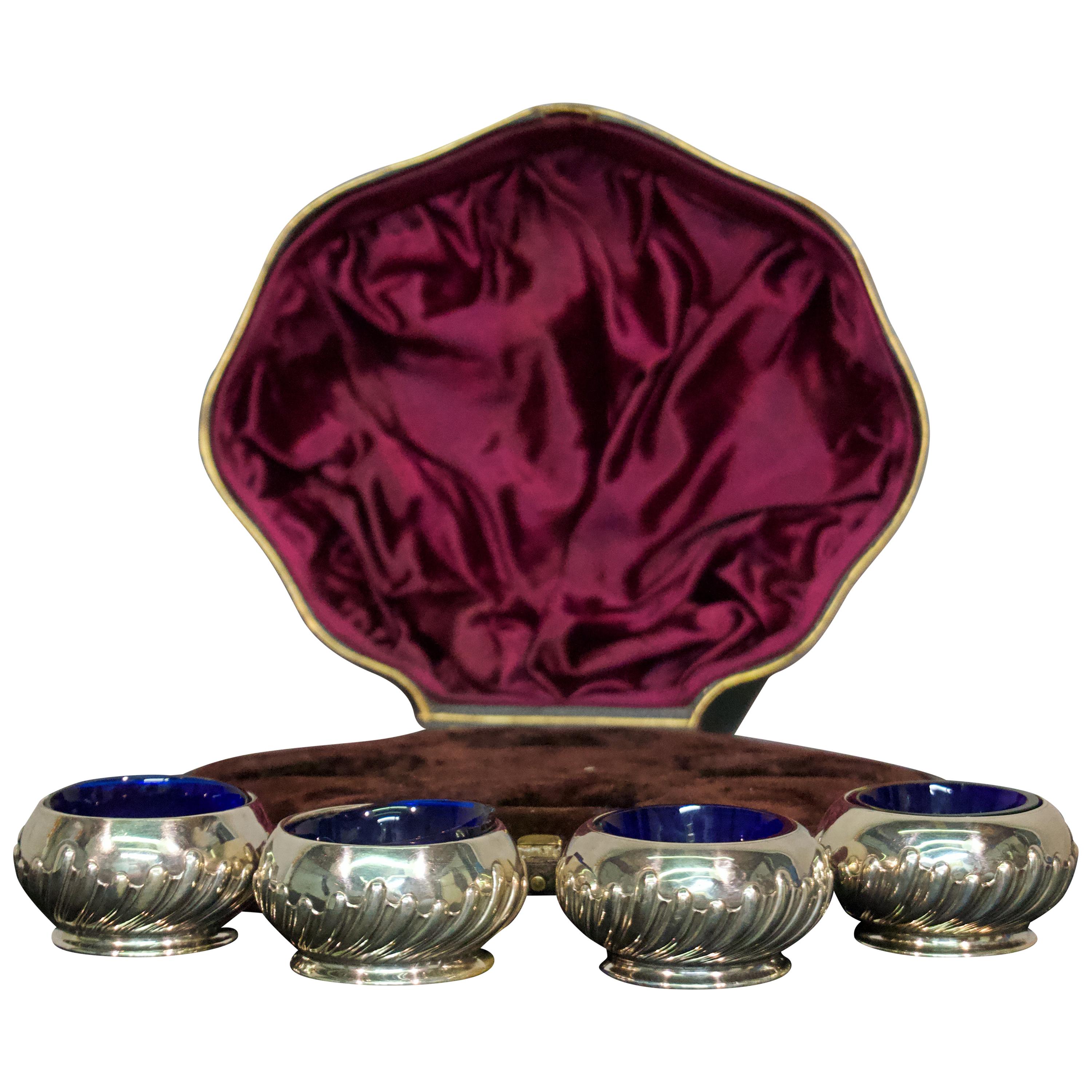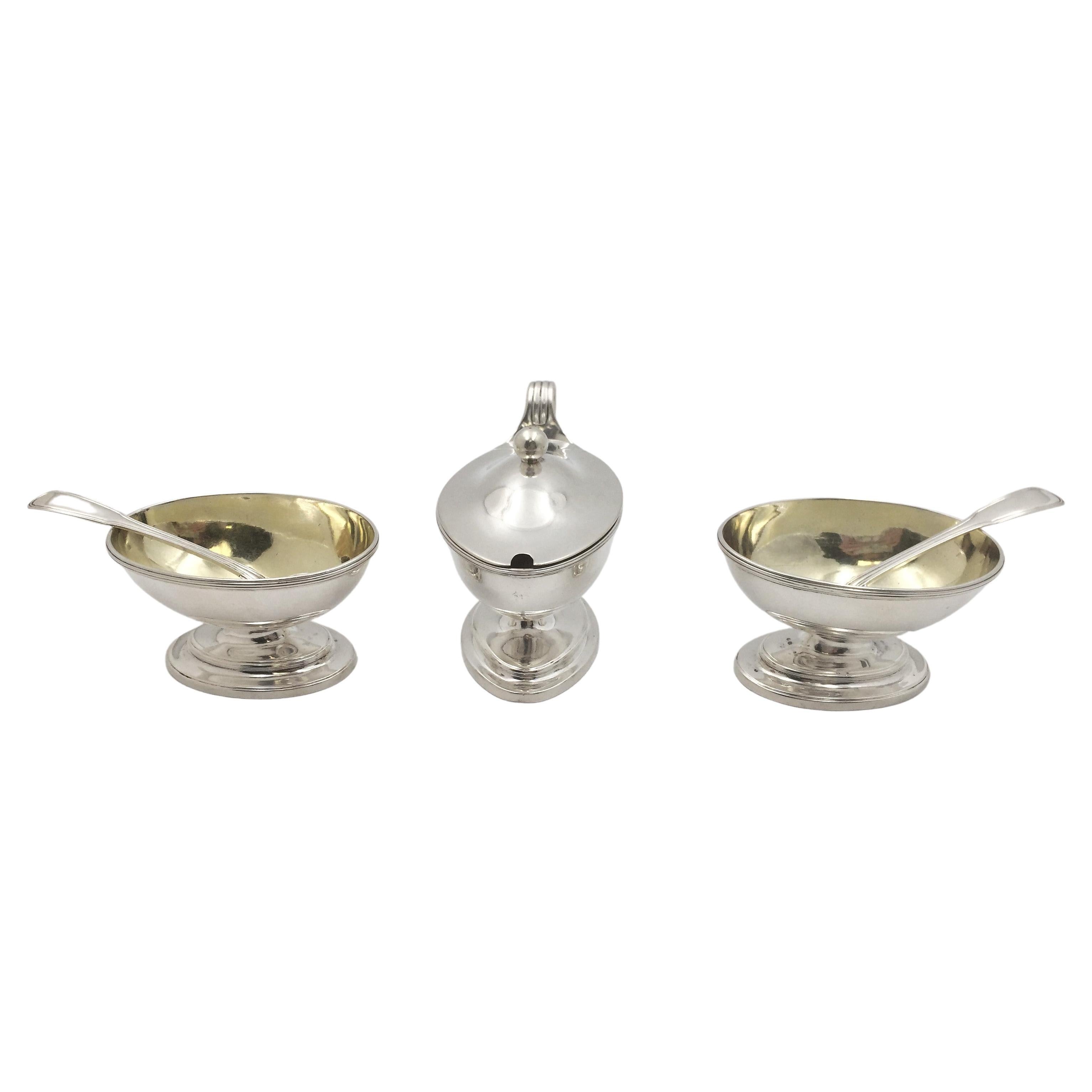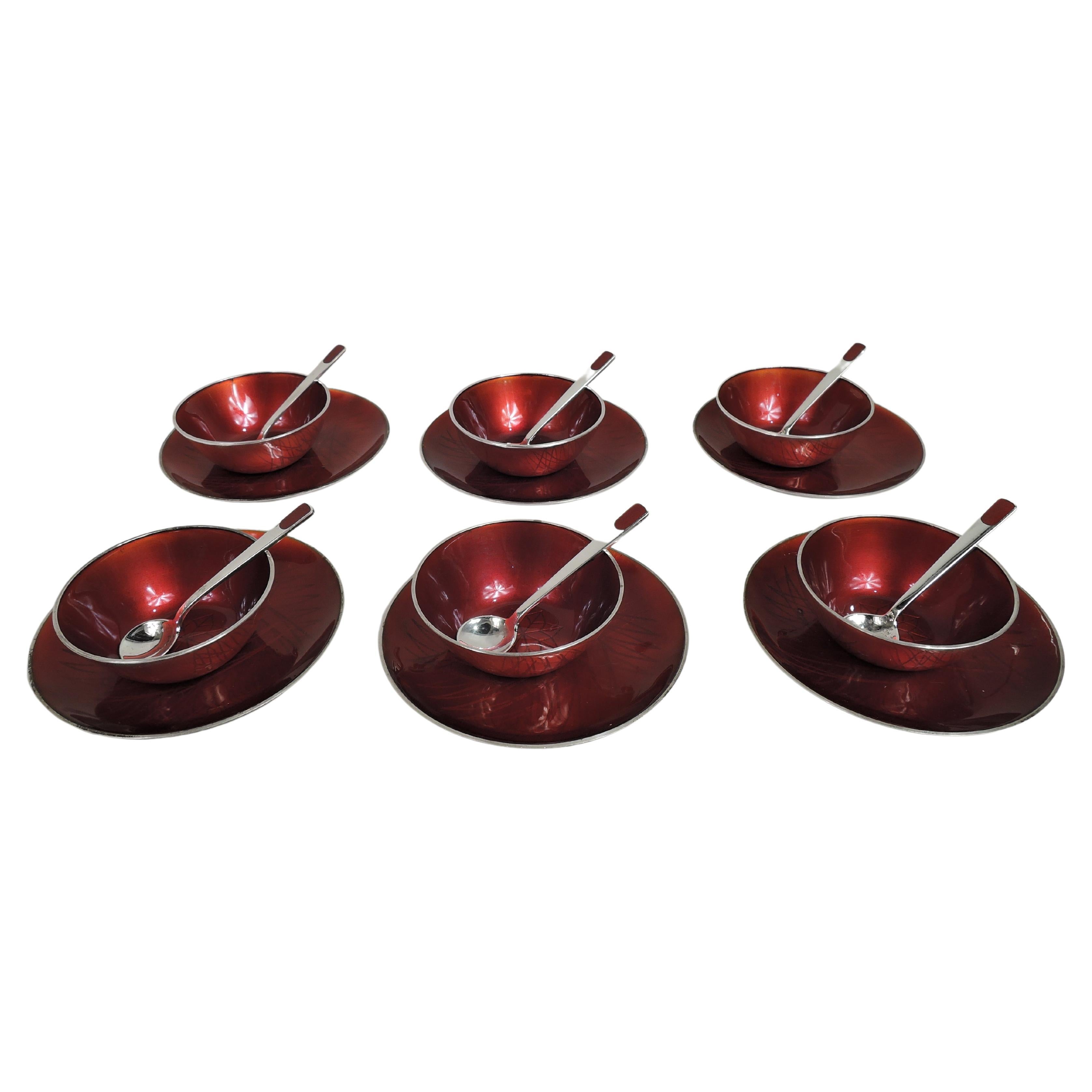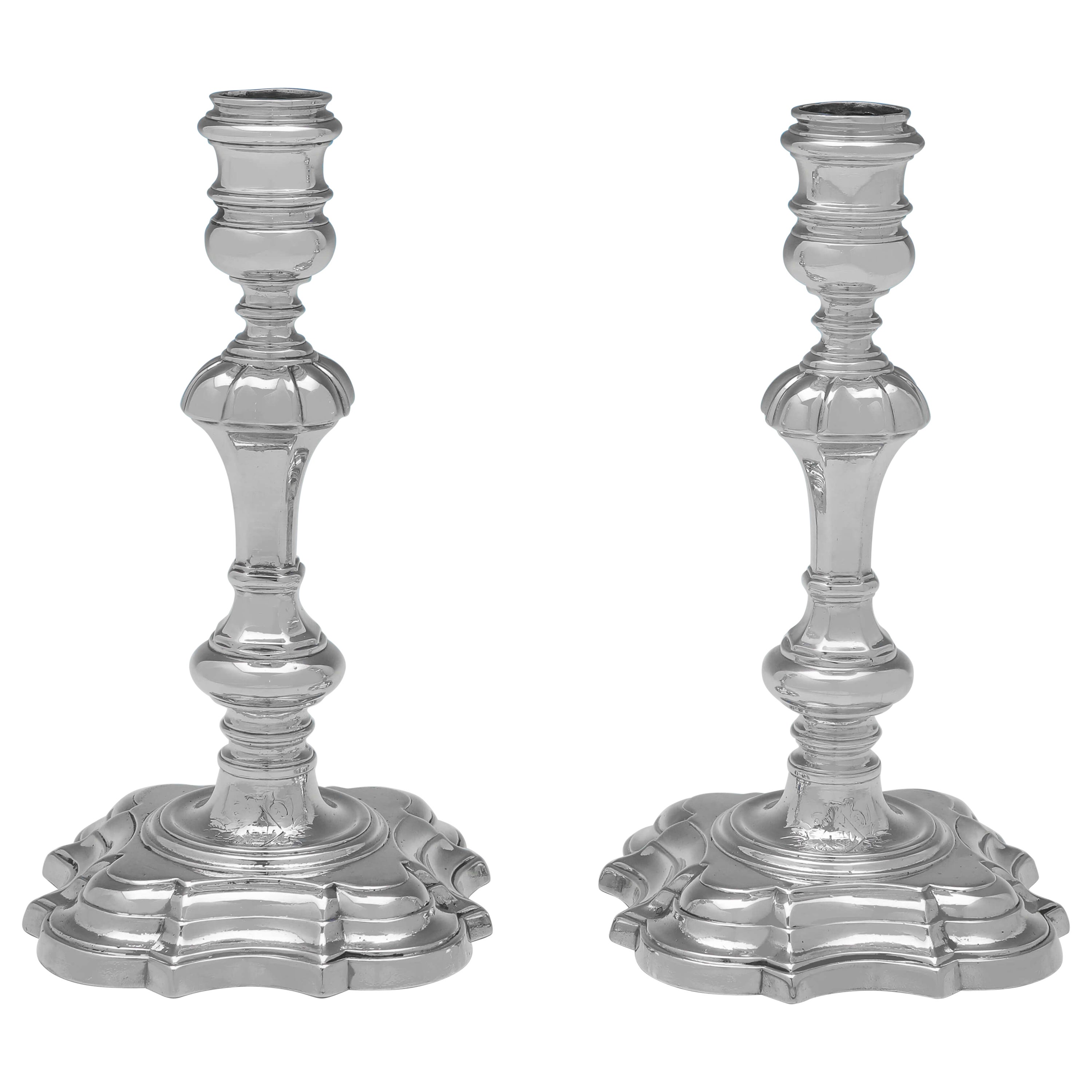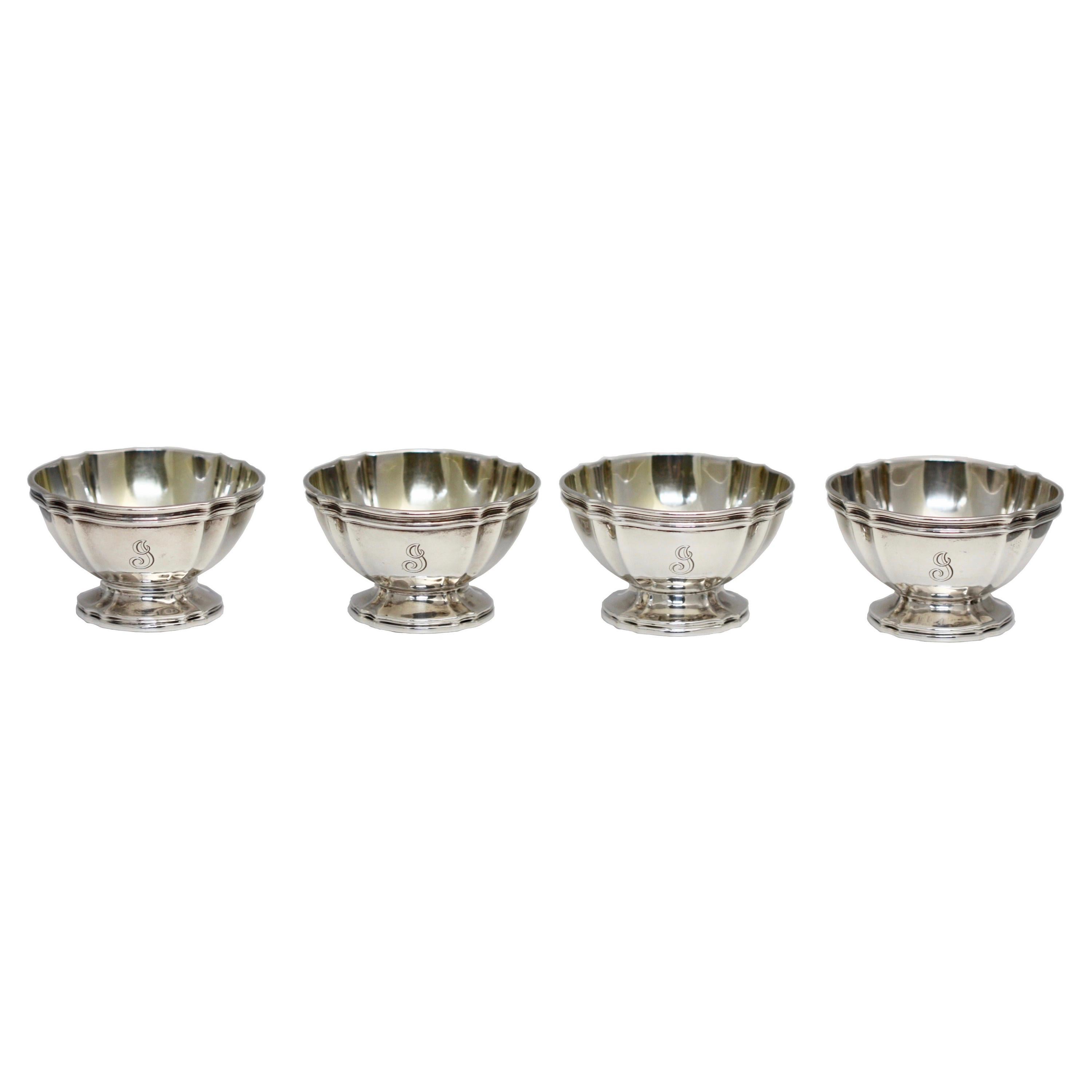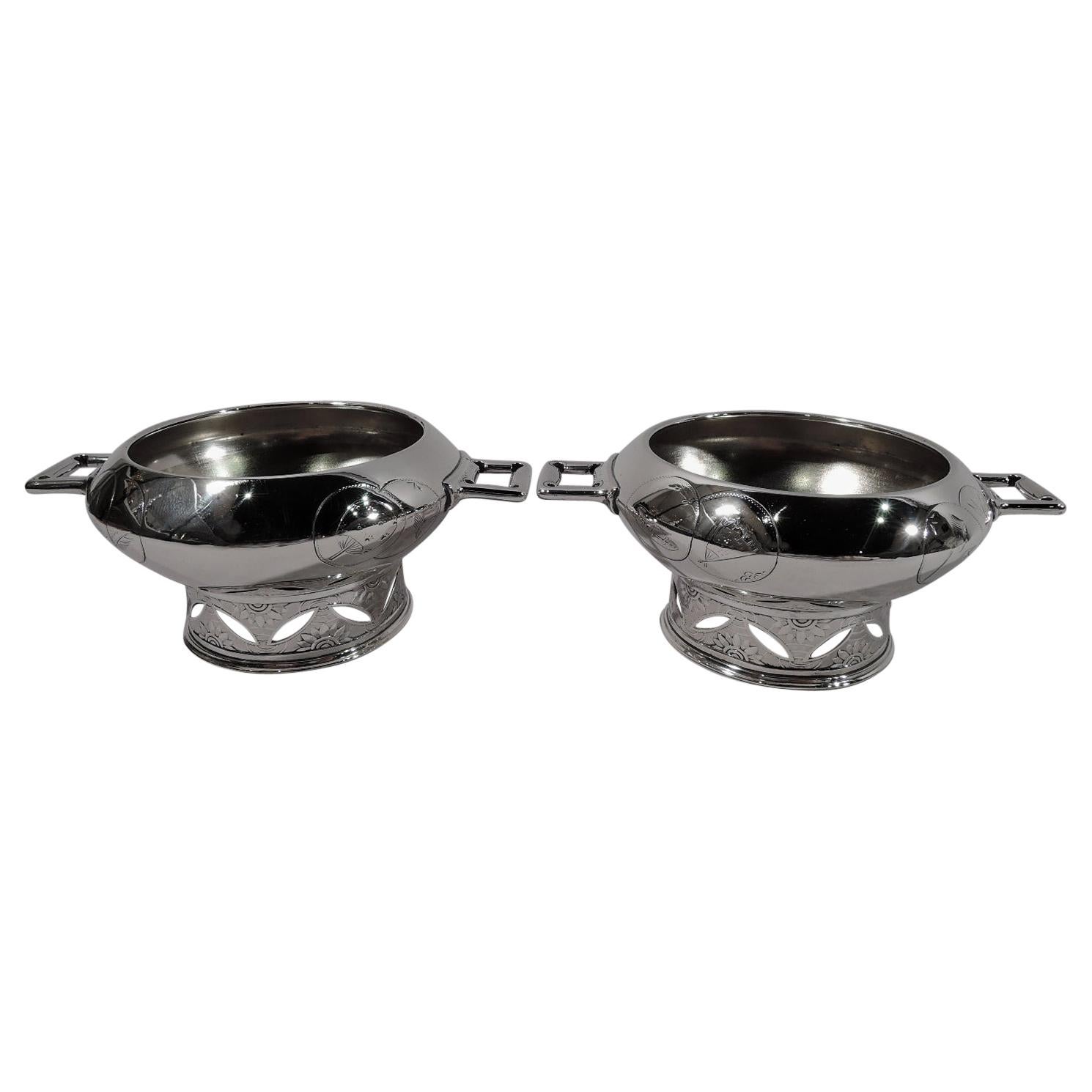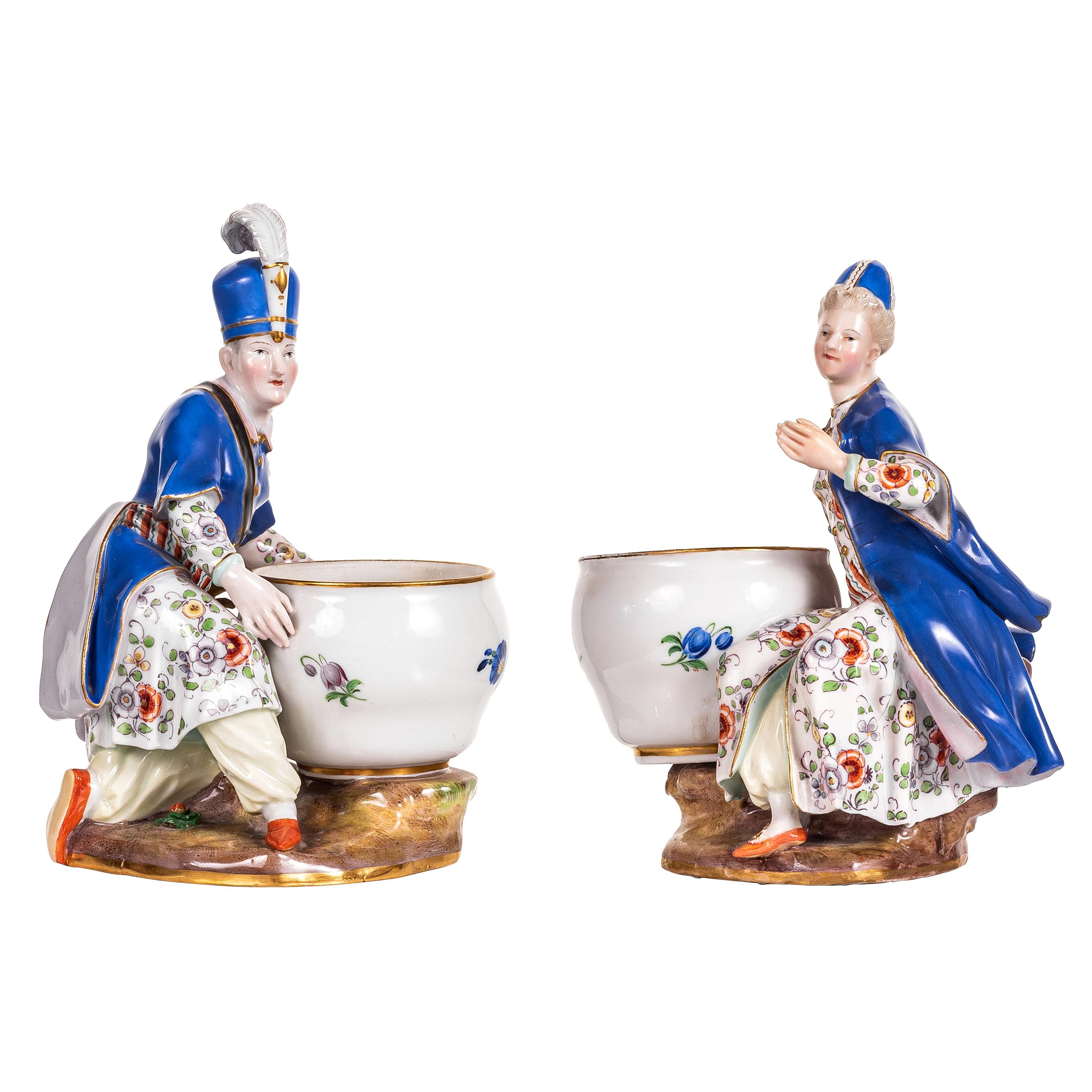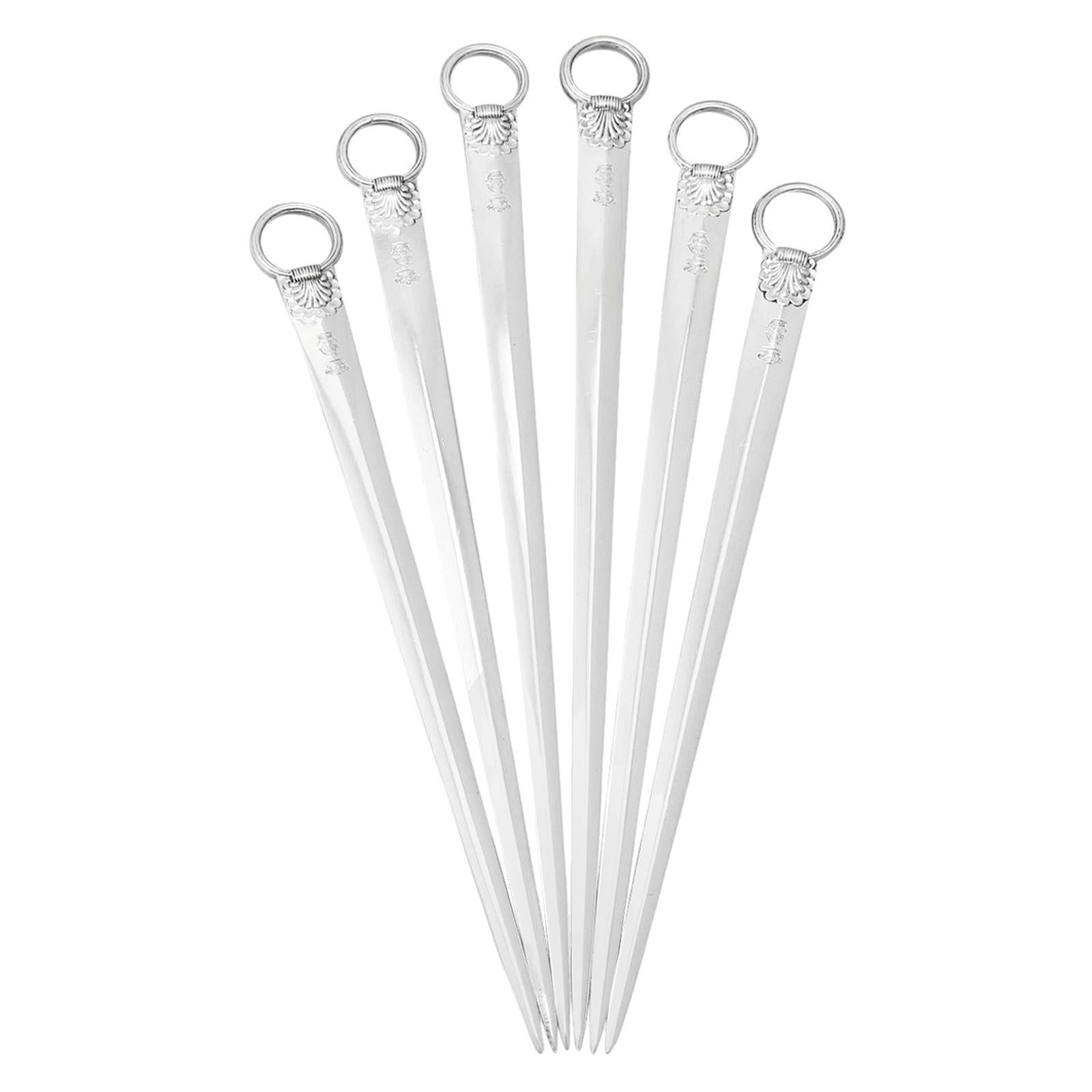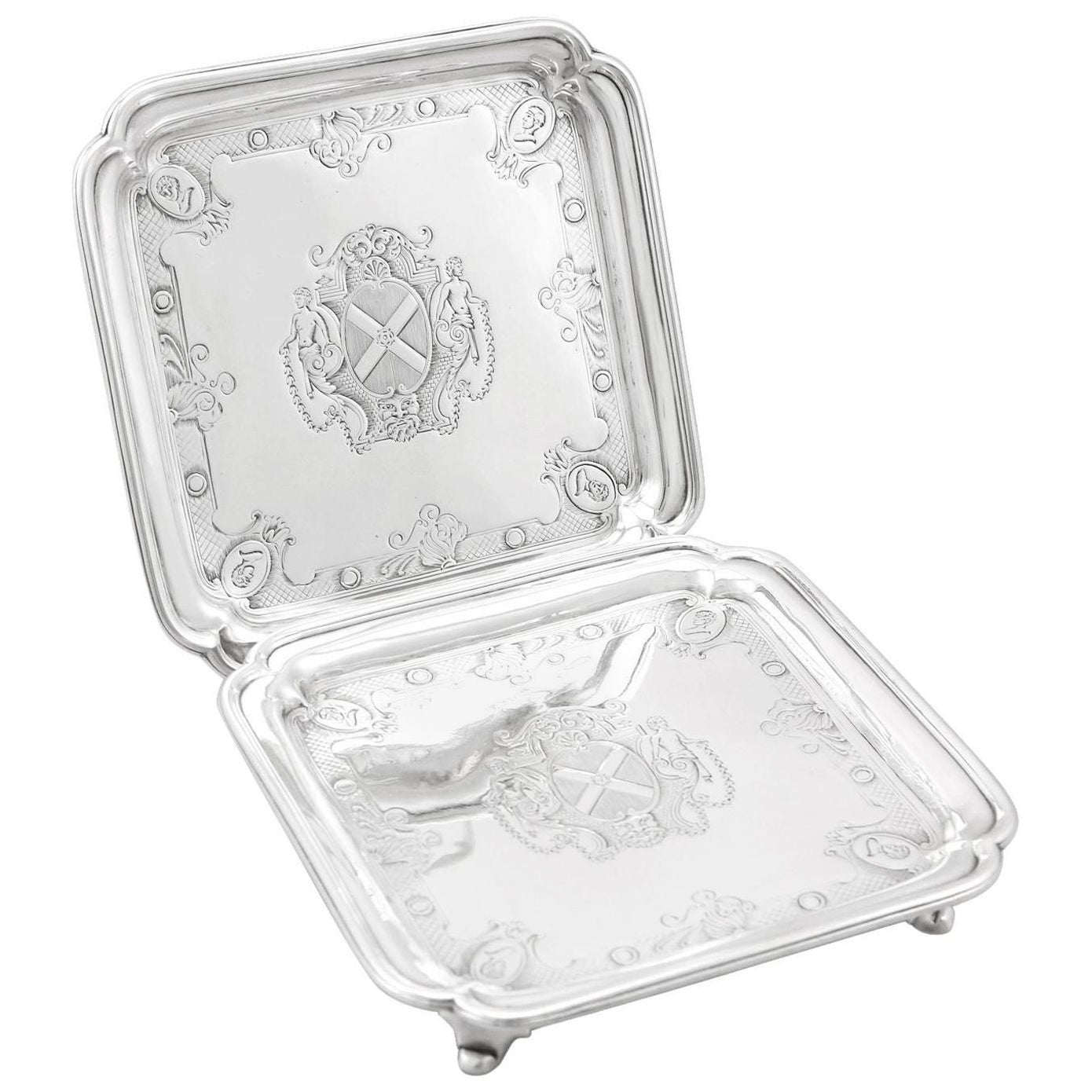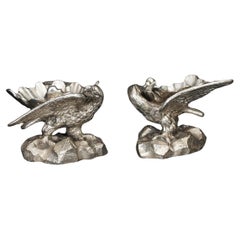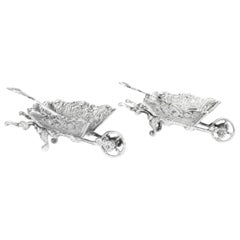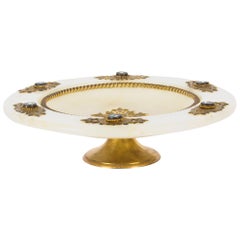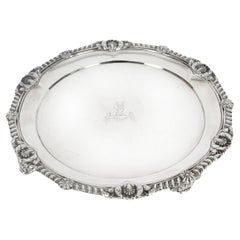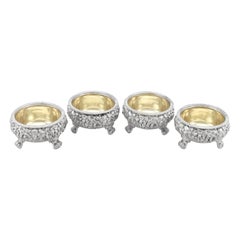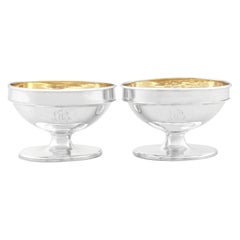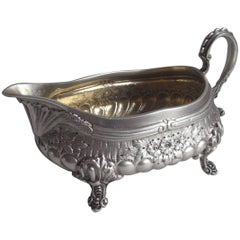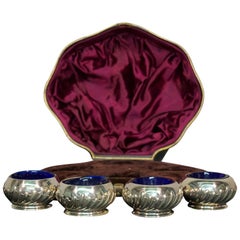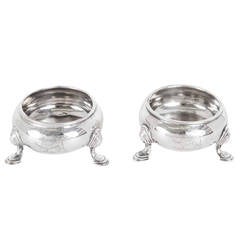
Antique Pair of Silver Salts by Paul de Lamerie 1734
View Similar Items
Want more images or videos?
Request additional images or videos from the seller
1 of 7
Antique Pair of Silver Salts by Paul de Lamerie 1734
About the Item
- Dimensions:Height: 1.97 in (5 cm)Width: 3.55 in (9 cm)Depth: 3.55 in (9 cm)
- Sold As:Set of 2
- Place of Origin:
- Period:
- Date of Manufacture:1734
- Condition:
- Seller Location:London, GB
- Reference Number:1stDibs: LU95061796172
About the Seller
5.0
Platinum Seller
Premium sellers with a 4.7+ rating and 24-hour response times
Established in 1983
1stDibs seller since 2012
1,353 sales on 1stDibs
Typical response time: 1 hour
Associations
LAPADA - The Association of Arts & Antiques Dealers
Authenticity Guarantee
In the unlikely event there’s an issue with an item’s authenticity, contact us within 1 year for a full refund. DetailsMoney-Back Guarantee
If your item is not as described, is damaged in transit, or does not arrive, contact us within 7 days for a full refund. Details24-Hour Cancellation
You have a 24-hour grace period in which to reconsider your purchase, with no questions asked.Vetted Professional Sellers
Our world-class sellers must adhere to strict standards for service and quality, maintaining the integrity of our listings.Price-Match Guarantee
If you find that a seller listed the same item for a lower price elsewhere, we’ll match it.Trusted Global Delivery
Our best-in-class carrier network provides specialized shipping options worldwide, including custom delivery.More From This Seller
View AllAntique Victorian Pair of Silver Plated Eagle Salts 19th C
Located in London, GB
This is a charming pair of antique Victorian silver plated salts each in the form of an eagle and in Baroque taste, circa 1880 in date.
The beautifully cast salts each feature a de...
Category
Antique 1880s Late Victorian Animal Sculptures
Materials
Silver Plate
Antique Pair of French Silver Salts as Garden Wheelbarrows, 19th Century
Located in London, GB
This is a charming pair of antique French silver novelty table salt condiments in the form of garden wheelbarrows, dating from the late 19th century.
Each wheel barrow having 'C' scroll Rococo style decoration to the bodies with shaped handles and a functioning wheel.
Both table salts having a silver shovel...
Category
Antique 1890s French Sterling Silver
Materials
Silver
Italian Pietra Dura Mounted Brass and Alabaster Comport Dish, 19th Century
Located in London, GB
This is a superb quality antique Italian Pietra Dura mounted, gilt brass and alabaster table-centre comport dish, dating from the late 19th century.
With striking pierced Neo-Gothic chased brass mounts this splendid alabaster dish is set with six highly decorative pietra dura roundels depicting various floral decoration.
It is raised on a sturdy circular brass base.
It is a sumptuous piece which will make a great statement in any special room.
Condition:
In really excellent condition, please see photos for confirmation.
Dimensions in cm:
Height 8 x width 29 x depth 29
Dimensions in inches:
Height 3.1 x width 11.4 x depth 11.4
Pietra Dura is a term for the inlay technique of using cut and fitted, highly polished colored stones to create images. It is considered a decorative art.
Pietre dure is an Italian plural meaning "hard rocks" or hardstones; the singular pietra dura is also encountered in Italian. In Italian, but not in English, the term embraces all gem engraving and hardstone carving, which is the artistic carving of three-dimensional objects in semi-precious stone, normally from a single piece, for example in Chinese jade.
The traditional convention in English has been to use the singular pietra dura just to denote multi-colored inlay work. However, in recent years there has been a trend to use pietre dure as a term for the same thing, but not for all of the techniques it covers, in Italian.
But the title of a 2008 exhibition at the Metropolitan Museum of Art, New York, Art of the Royal Court: Treasures in Pietre Dure from the Palaces of Europe used the full Italian sense of the term, probably because they thought that it had greater brand recognition. The material on the website speaks of objects such as a vase in lapis lazuli as being examples of "hardstone carving (pietre dure)"
The Victoria & Albert Museum in London uses both versions on its website, but uses pietra dura. "A method of inlaying colored marbles or semi-precious stones into a stone base, often in geometric or flower patterns...."
Giovanni Montelatici...
Category
Antique 1890s Italian More Dining and Entertaining
Materials
Alabaster, Brass
Antique George III Sterling Silver Salver by Paul Storr 1811 19th Century
By Paul Storr
Located in London, GB
This is a wonderful English antique George III sterling silver 10 inch salver, by the world famous silversmith Paul Storr.
It has clear hallmarks for London 1811 and the makers mark of Paul Storr.
It is typical of his work with the raised gadrooned rim with anthemion at intervals, on four fabulous foliate bracket feet. The salver is engraved with a crest and motto and the underside is later engraved
Charlotte J. Parke from C. J. Parke, March 1893'
The centre is engraved with a crest above a motto 'True and Fast' and I have researched this crest:
The Crest of Parke
The crest as engraved upon this George III English Sterling Silver Footed Salver by Paul Storr hallmarked London 1811 is that of the family of Parke. It may be blazoned as follows:
Crest: A stag’s head couped sable holding in the mouth a key or
Motto: True and fast
The family of Parke originally hailed from the County of Cumberland in the northeast of England1 later settling in the County of Dorset at Henbury House, Sturminster Marshal, near Wimborne. Given the evidence of the inscription found on the underside of the salver ‘Charlotte J. Parke from C. J. Parke, March 1893’ it was undoubtedly at one time in the possession of Charles Joseph Parke (died 9th March 1893) of Henbury House aforesaid and gifted to Charlotte Josephine Parke (baptised 4th January 1857 died 2nd January 1941) his third daughter by his wife, Ellen Mary Ethelston. I would venture the following hypothesis that the salver was bequeathed to Charlotte in her father’s will that was granted probate at London on the 20th May 1893. The ‘March 1893’ of the inscription acts as a remembrance of the month of the death of her father. It was noted that Charlotte’s father left an estate worth some £66,892, 19 shillings and one pence, a very considerable sum in the last decade of the 19th Century and even thereafter. Charlotte never married and was living at the time of her death at The Coppice, Sixpenny Handley in the County of Dorset. Her will was proved for probate at Llandudno on the 25th March 1941. She left an estate worth £18,866, 10 shillings and 4 pence. Again, a comfortable sum in 1941.
See the photo of Henbury House, Sturminster Marshal, near Wimborne, Co. Dorset. The former seat of the Parke family. The house was destroyed by fire, the remains of which were demolished in the 1990's.
There is no mistaking its unique quality and design, which is sure to make it a treasured piece by any discerning collector.
Condition:
In excellent condition with clear hallmarks and no dings, dents or signs of repair. Please see photos for confirmation.
Dimensions in cm:
Height 2 x Width 26.5 x Depth 26.5
Weight 0.69 kg
Dimensions in inches:
Height 1 inch x Width 10 inches x Depth 10 inches
Weight 1.5 lbs
Paul Storr
born in London England in 1771, was to become one of the most talented silversmiths of the nineteenth century. Today his legacy of exceptionally well crafted silver, found worldwide in museums and private collections, leaves one in awe when compared to that of his contemporaries.After having served a seven year apprenticeship from the age of 14, he began his career in 1792 when he went into a brief partnership with William Frisbee. This did not last and in 1793 a new mark, (his initials ‘P S’) was entered. By the beginning of the nineteenth century he had established himself as one of London’s top silversmiths producing, amongst others, commissions for Royalty.
In 1801 he married Elizabeth Susanna Beyer with whom he was to have ten children. In 1807 Paul Storr entered into a working relationship with Philip Rundell and by 1811 was a partner, and managing the workshops for Rundell, Bridge & Rundell.
During this period he kept his own marks and separate workshop. However it was through Rundell, Bridge & Rundell who were appointed Goldsmith in Ordinary to George III in 1804 that his reputation as a master silversmith grew. His talents lay in being able to transform ideas and designs from Rundell, Bridge & Rundell’s designers, William Theed...
Category
Antique 1810s English George III Sterling Silver
Materials
Sterling Silver
Antique Rare Georgian Sterling Silver Teapot by Paul Storr 1812 19th Century
By Paul Storr
Located in London, GB
This is an exceptional and very rare antique English George III sterling silver teapot by the world famous silversmith, Paul Storr, 1810 in date.
This splendid teapot is of a deligh...
Category
Antique 1810s English George III Platters and Serveware
Materials
Silver
Antique Large William IV Silver Tray Salver by Paul Storr 19th Century
By Paul Storr
Located in London, GB
This is a wonderful English antique William IV sterling silver tray, or salver, by the world famous silversmith Paul Storr.
It has clear hallmarks for London 1820 the makers mark of Paul Storr.
It is typical of his work with the octafoil shape and the exquisitely detailed reeded rim, and it is raised on four delightful foliate and scroll feet.
The centre is engraved with a shield shaped coat of arms which I have had researched.
The Marital Arms of Knollis and Hallifax
The armorial bearings as engraved upon this George IV Large English Sterling Silver Footed Salver by Paul Storr hallmarked London 1820 are those of the family of Knollis with Hallifax in pretence. These armorial bearings denote the marshalling of a marital coat showing the arms of the husband over the entire surface of the shield, whilst the arms of the wife (as an heraldic heiress) are placed on a small shield (known as an escutcheon of pretence) centrally on the husband’s arms.
They may be blazoned as follows:
Arms:
Quarterly 1st and 4th Azure crusily of cross crosslets a cross moline voided or (for Knollys) 2nd and 3rd Gules on a chevron argent three roses of the field barbed proper (for Knollys) over all an escutcheon of pretence Or on a pile engrailed sable between two fountains barry wavy of six argent and azure three cross crosslets of the first (for Hallifax)
Crest:
An elephant argent [differenced with a mullet1 ] (for Knollys)
Motto:
In utrumque paratus [Prepared for either] (for Knollys)
These armorial bearings undoubtedly commemorate the marriage of The Honourable and Reverend Francis Knollis2 (baptised 3rd January 1743 died 27th February 1826),
1 The cadency mark for a third son of a family. 2 Francis appears to have preferred this spelling of his family’s surname. It is spelt as it is to be pronounced.
of Burford in the County of Oxfordshire and of Eastleach Martin in the County of Gloucestershire and Mary Hallifax (baptised 5th March 1753 buried 18th December 1830). Francis and Mary were married at the Parish Church of St Mary, Ewell in the County of Surrey on the 9th June 1772. Francis was the third son of Charles Knollys (the titular 5th Earl of Banbury) 3 and his wife, Martha Hughes, whilst Mary was the daughter of The Reverend James Hallifax, of Ewell aforesaid and his wife, Elizabeth Chardavoyn.
3 Francis’s father claimed to be the 5th Earl of Banbury. A claim that continued to be pursued by the family until William Knollys, the titular 8th Earl of Banbury (born 1763 died 1834) was forced to discontinue its use by a resolution of the House of Lords which rejected his claim to the earldom in 1813.
The crest surmounts a detailed dedication:
This piece of plate was presented to the Honourable Rev Knolls by the inhabitants of the town and immediate neighbourhood of Burford on his completing the fiftieth year of his incumbency as the vicar of Burford.
In testimony of their high respect 11th April 1821
There is no mistaking its unique quality and design, which is sure to make it a treasured piece by any discerning collector.
Condition:
In excellent condition with clear hallmarks and no dings, dents or signs of repair. Please see photos for confirmation.
Dimensions in cm:
Height 3 x Width 36 x Depth 36
Weight 1.52 kg
Dimensions in inches:
Height 1 inch x Width 1 foot, 2 inches x Depth 1 foot, 2 inches
Weight 49 troy oz
Paul Storr
born in London England in 1771, was to become one of the most talented silversmiths of the nineteenth century. Today his legacy of exceptionally well crafted silver, found worldwide in museums and private collections, leaves one in awe when compared to that of his contemporaries.After having served a seven year apprenticeship from the age of 14, he began his career in 1792 when he went into a brief partnership with William Frisbee. This did not last and in 1793 a new mark, (his initials ‘P S’) was entered. By the beginning of the nineteenth century he had established himself as one of London’s top silversmiths producing, amongst others, commissions for Royalty.
In 1801 he married Elizabeth Susanna Beyer with whom he was to have ten children. In 1807 Paul Storr entered into a working relationship with Philip Rundell and by 1811 was a partner, and managing the workshops for Rundell, Bridge & Rundell.
During this period he kept his own marks and separate workshop. However it was through Rundell, Bridge & Rundell who were appointed Goldsmith in Ordinary to George III in 1804 that his reputation as a master silversmith grew. His talents lay in being able to transform ideas and designs from Rundell, Bridge & Rundell’s designers, William Theed...
Category
Antique 1820s English William IV Sterling Silver
Materials
Sterling Silver
You May Also Like
Antique Sterling Silver Salts, 1818
Located in Jesmond, Newcastle Upon Tyne
An exceptional, fine and impressive set of four antique Georgian English sterling silver salts; an addition to our silver cruet and condiment collection
...
Category
Antique 1810s English George III Sterling Silver
Materials
Sterling Silver
Henry Chawner Antique 1790s Sterling Silver Salts
By Henry Chawner
Located in Jesmond, Newcastle Upon Tyne
A fine and impressive pair of antique Georgian English sterling silver salts made by Henry Chawner; an addition to our silver cruet and condiment collection.
These fine antique George III sterling silver salts have a plain rounded oval form to an oval pedestal foot.
The surface of each salt is encircled with a plain applies girdle above the contemporary engraved initials 'EPC'.
The oval feet and upper rims of these impressive examples of Georgian silverware are encircled with applied thread decorated borders.
These antique salts, crafted by the renowned London silversmith Henry Chawner, have gilded interiors.
Condition
These antique silver salts...
Category
Antique 1790s British George III Sterling Silver
Materials
Silver, Sterling Silver
Rare Cast Cream Boat, in the Manner of Paul de Lamerie, Made in London in 1890
Located in London, GB
The cast cream boat is of a very unusual design in the manner of Paul de Lamerie. This piece stands on four scroll feet attached to the sides with foliate mouldings. The main body ha...
Category
Antique Late 19th Century English More Dining and Entertaining
Regency Sterling Silver, Silver Salts
Located in Huntington, NY
With cobalt blue glass bowl inserts and leather presentation case.
Dimensions:
Box width 7 ½, depth 7”, height 2 3/4”
Containers diameter 2”,...
Category
Antique 19th Century English Regency Sterling Silver
Materials
Sterling Silver
$2,960 Sale Price
20% Off
18th Century Pair of Sterling Silver Open Salts and Mustard Pot Georgian Style
By John Wakelin & William Taylor
Located in New York, NY
John Wakelin & William Taylor pair of sterling silver open salts from 1783 in Georgian style with gilt wash bowls and in exquis...
Category
Antique Late 18th Century English Georgian Sterling Silver
Materials
Silver, Sterling Silver
Set of 6 Danish Midcentury Sterling Silver & Red Enamel Open Salts
By Anton Michelsen, Eigel Jensen
Located in New York, NY
Set of 6 Mid-Century Modern sterling silver open salts with under plates and spoons. Made by Anton Michelsen in Copenhagen. Each salt: Round bowl with enameled interior and engraved ...
Category
Mid-20th Century Danish Mid-Century Modern Sterling Silver
Materials
Sterling Silver, Enamel
Recently Viewed
View AllMore Ways To Browse
Antique Silver Bath
Antique Sterling Salts
Antique Open Salts
18th Century Bath Tub
Ralph Lauren Teapot
Red Shagreen Coasters
Rosenthal Studio Linie Germany China
Scof Flatware
Sterling Silver Mint Julep Cup Fisher
Straw Placemats
Vintage Monumental Florentine Tray
Vintage Peanut Machine
Vintage Peanut Vending Machine
Wedgewood Hunting Scene China
Wedgwood Strawberry Lustre
Williams Sonoma Coffee Table
Klink Table
Kluskens Jumbo Dining Table
